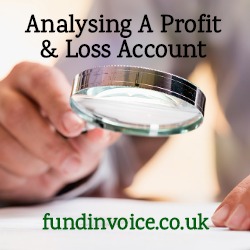- 07 Jun
How I Analyse A Profit And Loss Account
 Analysing the profit and loss account (P & L) of a company can give you some idea of how well the business is trading. You should be able to see if its sales volume is growing, or decreasing. You should also be able to see whether it is profitable, or it is loss making.
Analysing the profit and loss account (P & L) of a company can give you some idea of how well the business is trading. You should be able to see if its sales volume is growing, or decreasing. You should also be able to see whether it is profitable, or it is loss making.Profitability Versus Cash Flow
Growth or profitability provides no guarantee that you will be paid on time, or that the business even has the money to pay you. The historic nature of financial accounts means that you are always looking at out of date information.
Also, profitability is not the same as cash flow. You can sell something at a profit, but you don't have the cash from that sale until your debtor pays. Even profitable companies can be cash poor.
If you are cash poor and want to address that, get in touch and we can help you release the cash from your unpaid invoices. Just call Sean on 03330 113622.
Analysing The Profit And Loss Account
The first thing that I look for is the trading period over which the accounts are drawn. The normal course is for 12 months trading accounts to be filed each year. However, some companies will amend their year-end, in order to report on a longer or shorter period of time. This can obviously affect the results that you are reviewing.
For example, if you are comparing last years profit performance with the profit performance from this year period, and the current period is say 18 months, you would expect the profit returns to be 1.5 times the profit returned in the previous period, if the company made no further progress in terms of margins. If in an 18 month period a company returns the same profit as it did in the previous 12 months period, that would suggest that their trading position has declined.
Understanding Trading Performance
I always make a point of reading through all the pages of the accounts, including the notes in order to get the best understanding of a company’s situation. The profit and loss account is a record of their trading over a given period. Typically, the profit and loss account will show the sales, or turnover, that the company achieved. From this will be deducted the costs and expenses incurred, arriving at a profit or loss at the bottom of the account.
You can make several comparisons. Firstly, you can compare year on year performance. This will tell you how the company is progressing e.g. increasing sales, or reducing sales volumes. Increasing profits, or are profits declining? It can be useful to calculate percentages e.g. gross profit as a percentage of turnover, and then compare these year on year. You may have an absolute increase in terms of value, but the gross profit percentage could be declining, indicating an underlying issue with the cost of supply. The same approach can be taken to calculating and comparing the pre-tax profit percentage.
Another comparison can be with other businesses within the sector, or with industry norms. Once again, comparing percentages throughout the P & L can show deviations from the norm, regardless of absolute values.
Dividends
Take note of any dividend distribution. This is when a payment is made to the shareholders, so they should not be considered in the same way as say costs. Sometimes a dividend paid will show at the bottom of the P & L account as a deduction from the profit and loss account. A company could even pay a dividend in excess of the profit for the year, which makes the P & L account look like they made a loss.
Limited Information
Another complication When dealing with companies of even a reasonable size is that there are limitations in the requirement to file profit and loss information at all. A company can turnover several million pounds, and still not be required to file it’s profit and loss account - only being required to file a balance sheet. This can make understanding its trading success much more difficult.
The above is not intended to be a comprehensive guide to analysing financial accounts, and I am not an accountant, but it includes some pointers based on the approach that I tend to take. If you need help understanding financial accounts, you should seek support from a qualified accountant, but we can help if you are trying to protect against customer bad debts.
See related article : How I Analyse Financial Accounts.
- Home
- Business Financing
- Invoice Finance
- Invoice Discounting
- Factoring
- Debt Factoring
- Recourse Factoring
- Fund Selected Invoices
- Business Loans
- Construction Sector Funding
- Protect Against Bad Debts
- Exports Collection And Funding
- Import Funding
- Body Shop Funding
- Spot Factoring
- Retail Sector Funding
- Fund Invoices Confidentially
- Help Running Your Payroll
- CHOCs Customer Handles Own Collections
- Collect Invoices Confidentially And Funding
- Outsourcing Your Credit Control
- Asset Finance And Mortgages
- Case Studies
- About Us
- Testimonials
- Find Out More
- News
- Free Magazine
- Blog






